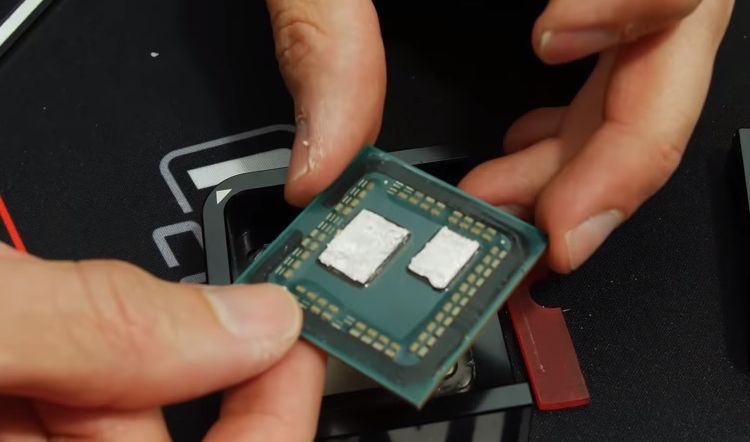Lifting the ban on publishing test results for the latest 7nm AMD Ryzen processors 3000 also affected those, who are used to squeezing everything possible out of the system, using liquid nitrogen as a means of cooling overclocked components. First of all, A famous German enthusiast made a video message to overclockers Exit 8auer, who criticized AMD's new policy regarding the assignment of frequencies in automatic overclocking mode. According to him, The enthusiast's own experiments showed, that the “advertised” AMD frequencies in “turbo mode” are rarely achievable in practice, and it’s hard to blame this specialist for lacking sufficient overclocking experience.
Removing the cover and replacing the thermal interface: there's no point anymore
In manual overclocking mode, according to the author of the video, 7-nm processors are overclocked using commonly used cooling methods to 4.2–4.3 GHz, and the line in 5 Not every processor can reach GHz even when using liquid nitrogen. In this way, Roman Hartung summarizes (Roman Hartung), ordinary people need to say goodbye to hopes of conquering the five gigahertz milestone with the help of air or even liquid cooling.
Roman also decided to remove the cover from the Ryzen processor 5 3600, since he had several copies of processors of this model at his disposal. Cutting the sealant around the perimeter of the processor using a blade, he used one of his tools to forcefully move the lid, after which the mechanical connection of the solder with the lid and the crystals on the processor substrate weakened, and the lid was removed. This processor model has a dual-chip design, computing cores are placed on a smaller chip, which is produced by TSMC using 7nm technology. By the way, The compact dimensions of the crystal are not a favorable factor in matters of extreme overclocking, since the heat flux density increases, and heat is more difficult to effectively remove from the crystal. In the case of Matisse processors, the situation is aggravated by the asymmetric placement of the crystal with computing cores on the substrate.
Replacing standard solder with a “liquid metal” type composition, Der8auer discovered, that the gap between the crystals and the inside of the cover could not be filled with a new thermal interface, because of which it was necessary to reduce the thickness of the processor cover around the perimeter using abrasive processing. These manipulations did not bring a significant effect in terms of improving temperature or frequency potential, Therefore, Roman does not recommend replacing the standard thermal interface with an alternative one. Moreover, such actions always lead to loss of warranty on the processor.
Eight and twelve cores accelerated to similar frequencies
Moving directly to the discussion of the results of extreme overclocking of 7nm Ryzen processors, you should remember the nature of sorting crystals by frequency potential. AMD representatives admitted, what's on the Ryzen model? 9 Only selected copies are sent, therefore, their overclocking potential may be better in absolute terms. Another thing, that the nominal frequencies of these processors are closer to the limit of capabilities, therefore, the actual performance increase will not be noticeable.
so, Most of the extreme overclocking results recorded so far in the HWBot database are achieved using the MSI MEG X570 GODLIKE motherboard. It is not excluded, that the board has sufficiently developed functionality for this, but with such small sample sizes it’s simply too early to judge. MSI probably actively collaborated with overclockers in their experiments, which allowed her to glorify her motherboard.
Ryzen processor 9 3900X has been validated by CPU-Z at frequency 5455 MHz with all twelve cores and twenty-four threads active, while it was cooled with liquid nitrogen. Computational load in a number of other experiments reduced the effective processor frequency to the level of 5.0–5.2 GHz. The rule applies during acceleration, according to which a decrease in the number of active cores leads to an increase in the resulting frequency. In the case of overclocking eight-core Ryzen 7 3800X it worked, according to HWBot statistics.
So, eg, no load Ryzen processor 7 3800X was overclocked in eight-core mode to 5911 MHz, and he performed various kinds of calculations at frequencies from 5,5 GHz to 5,6 GHz. We are talking about experiments using liquid nitrogen, which allow you to reach the specified frequencies only for a short time.
Great progress in memory overclocking
Upgraded memory controller, as noted in all reviews of 7nm Ryzen processors 3000, is a source of special pride for AMD. Really, faster memory modes are available natively to these processors. However, memory operating mode in 7nm processors with Zen architecture 2 tied to Infinity Fabric bus, and therefore in our review of processors we made a recommendation not to increase the memory frequency above DDR4-3600, since with further overclocking the performance of the entire system may even suffer.
Overclockers are not that category of enthusiasts, which can be stopped, and the asynchronous mode of operation of memory and Infinity Fabric is precisely provided for such cases. To the Taiwanese enthusiast OKAY succeeded using a Ryzen processor 5 3600 overclock a single memory module with a capacity 8 GB up to DDR4-5774 mode at latency values 22-26-26-46-127-1. In the HWBot rating, this result corresponds to fourth place among the best achievements in DDR4 overclocking, and the first three positions are occupied by the much more expensive Core i9-9900K processor. Besides, the world record now corresponds to DDR4-5886 mode, and the Intel platform went towards it for many months. Probably, with due attention from overclockers to this challenge, the AMD platform will be able to move to higher positions in this ranking soon enough.
